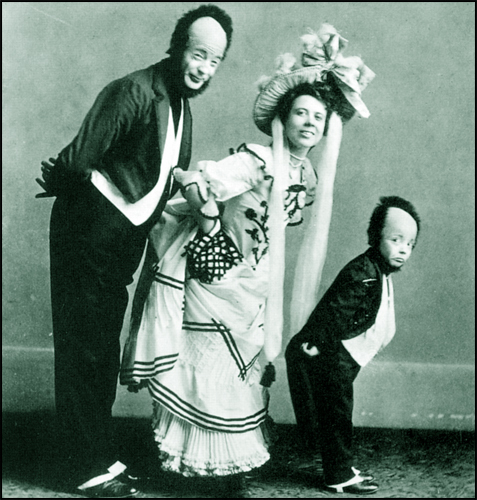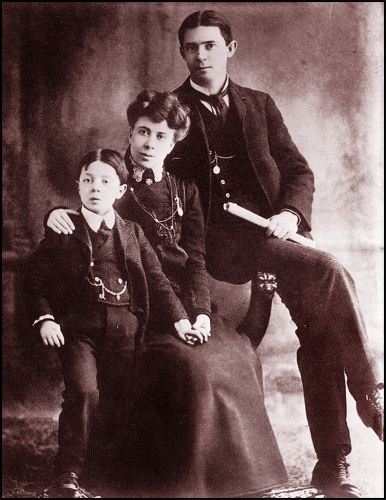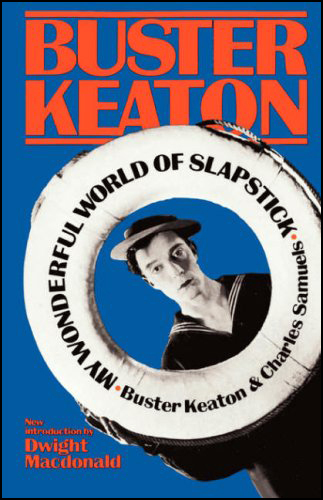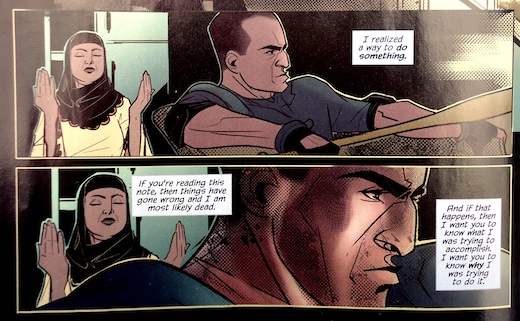One day in early 1896, a toddler barely able to walk accidentally tumbled head-over-heels down a long flight of stairs. People gasped and rushed to help, but when they reached the bottom of the landing they saw the little boy sitting up, a bit dazed but without serious injury. “That’s some buster your kid took!” someone exclaimed to the boy’s father, and with that the crowd dispersed, murmuring their collective astonishment that the tot hadn’t killed himself.
Hearing this, and looking down at the little stinker crawling around his feet, vaudevillian Joe Keaton decided that his young son would be called “Buster” from then on.
(In later years, Buster created the myth that it was family friend and fellow vaudevillian Harry Houdini who had witnessed the fall and bequeathed the nickname. Not true, but as far as can be discerned Keaton is the first person ever to take “Buster” as a given name — the comic strip Buster Brown didn’t debut until a few years later.)
Buster’s pop, Joe Keaton (1867-1946), was a tall, gangly, acrobatic flip-flop expert. “The Man With a Table” he called himself — placing a wooden chair on a sturdy table, he would stand atop them and perform a series of precarious falls, tumbles, handstands and dives, careening to the ground and then bounding back up again. “[My father] was the most gifted man at taking a fall I ever saw in action,” Buster would later say. Meanwhile his mother, Myra Keaton (1877-1955), sang songs and played a wide variety of musical instruments — harmonium, cornet, even a newfangled brass contraption called a saxophone.
Together the Keatons performed in turn-of-the-century “medicine shows”: small groups of itinerant performers traveling the country, performing skits, tricks and plays in between sales pitches from fake doctors selling snake-oil elixirs to gullible small-town rubes. (Judging from the modern proliferation of vitamins, bodybuilding powders, and exotic eastern herbal remedies, little has changed in the intervening century.) For years they were nondescript, just one of the thousands of similar acts out there dancing, singing, and clowning for their daily bread.
Then Buster came along.
At three years old, he was allowed to stand in the background during his parents’ act as window dressing, just as a way to keep an eye on him while they were busy on stage. But it wasn’t long before the little squirt began imitating his father’s dancing and tumbling behind his back, inspiring gales of laughter from audiences. Seeing how easily his son took to performing — and how appealing he was to paying customers — Joe Keaton began dreaming up of ways to integrate him into his act.
All of the other kids in vaudeville were crafted by their parents into “cute and charming Little Lord Fauntleroys” and “Dolly Dimples types with long, golden curls.” Joe Keaton, therefore, endeavored to make his boy, in Buster’s words, “the only little hell-raising Huck Finn-type boy in vaudeville.”
Experimenting with different storylines and testing them against audience reactions, Buster’s father finally hit upon a winning formula. “”They got the idea,” Buster later explained, “of trying to show the audience how to bring up children correctly. And every time I did something he didn’t like, he’d either take me by the back of the neck and throw me through a piece of scenery or kick me clean off the stage, through chairs, tables, or anything else that would be in the way.”
Frank Cullen, author of Vaudeville, Old and New: An Encyclopedia of Variety Performers in America, provides details of the act culled from contemporary newspaper reports:
Joe and Buster were dressed as stage Irishmen, with skullcap wigs that simulated a bald pate with curly hair around the edges leading into their chin whiskers. They wore baggy pants, short coats over white vests and spats over their slap shoes. . .
Buster played the mischievous imp to his father’s put-upon and often explosive character. . . While Joe attempted to sing a comic song or render a recitation, little Buster, dressed identically, would be stalking imaginary flies upstage and swatting them with a small broom, edging nearer to his dad until he “accidentally” thwacked Joe. From that point onward the violence escalated. Myra had sewn a suitcase handle onto the back of Buster’s coat so that Joe could pick him up and tote him about like luggage or toss him into the wings, up against the backdrop, or, occasionally, into the audience. Joe got as good as he gave: one resounding whack from Buster with his broom regularly sent Joe headfirst over the edge of the stage so that he was hanging into the orchestra pit. . . audiences unfamiliar with the act were aghast at the way Joe kicked and tossed his son about the stage. . .
For a closing, Myra came on dressed in her finery . . . Borrowing a gag from burlesque, for their call at the end of the act, Joe hitch-kicked Myra’s hat off her head while Buster yanked a cord that stripped Myra of her gown, leaving her standing in an Irish costume like Joe and Buster’s.
Soon Buster was being referred to as “The Human Mop,” due to the amount of time he spent sliding across the stage and slamming through props. “The Little Boy Who Can’t Be Damaged!” the ads read. “A revelation in eccentric juvenile talent, properly directed to produce the lasting comedy effects! The most unique character in vaudeville! A miniature comedian, who presents irresistible comedy, with gigantic effects!”
And the clincher: “Making the ladies hold their sides, too.”
“It was the roughest knockabout act that was ever in the history of the theater,” Keaton would later brag with familial pride. “As I grew older, our act became progressively rougher. For one thing, we never bothered to do the same routines twice in a row. We found it much more fun to surprise one another by pulling any crazy, wild stunt that came into our heads.”
One night his father might send him sailing across the stage and smack through a large drum sitting in the orchestra pit. On another, he might toss him headfirst into the audience itself. By the time the act wound down in Buster’s late teens, his Dad’s right arm was twice as big as his left from all the years of hurling his ever-growing boy.
Various child-protection groups, of course, did their best to shut down the act. “Reformers in New York, Massachusetts, and Illinois, among other states, were tireless in their efforts to stop us all from going to hell via the stage.” Keaton remembered. “I guess they meant well, but like so many other sincere do-gooders they were a pain in the neck, particularly to those they were attempting to rescue.”
Luckily for The Three Keatons, the very strangeness of their act often allowed them to skirt such roadblocks. “The law,” Keaton explained in his autobiography, “said that no child under the age of sixteen can walk wire, juggle, do acrobatics, roller-skate, play musical instruments — all of those — an awful list of things. But none of them” he added with a mischievous twinkle in his eye, “said that you couldn’t kick him in the face.”
When the little moppet would careen through chairs, over tables, and into brick walls, audiences didn’t know whether to laugh or rush to save the child from a horribly abusive father. “The people out front were amazed because I did not cry,” wrote Keaton. “There was nothing mysterious about this. I did not cry because I wasn’t hurt. All little boys like to be roughhoused by their fathers.”
Similar misconceptions would plague Buster’s career later in life as well. “Because of the way I looked on the stage and screen,” he wrote in his autobiography, “the public naturally assumed that I felt hopeless and unloved in my personal life.” The impression was buttressed when audiences saw him, aged and forlorn-looking, playing cards with other washed-up silent stars in Sunset Boulevard (1950), or performing a last silent-era tribute routine with Charlie Chaplin in Limelight (1952). In those films it was easy to look at his solemn, wrinkled face and imagine that all of his troubles — the alcoholic binges, losing his M-G-M contract and stardom, divorcing his first two wives — left him a tired, depressed, and bitter man in his elder years.
“Nothing could be father from the fact,” he assured everyone who would listen, “As long back as I can remember I have considered myself a fabulously lucky man. . . the bad years, it seems to me, were so few that only a dyed-in-the-wool grouch who enjoys feeling sorry for himself would complain of them.” And over that lifetime of fortune and fame, Keaton insisted that, “My parents were my first bit of great luck.”
The skills, athleticism, and genius of the singularly gifted physical comedian who made The Cameraman just didn’t come to him out of thin air. When you’re laughing at that movie’s hilarious pratfalls, breathlessly dangerous stunts, and inspired comic hi-jinks, you’re not just witnessing the end of silent film, but the swan song of one of the keepers of the lost and vanished art of vaudeville. The art of his Mom and Dad.
Previous posts in the series “Buster Keaton and The Cameraman“
FURTHER READING and VIEWING
Notes on The Cameraman by Kevin Hagopian: A nice article on Keaton and his last great film, worth a read.
Debunking the Buster Keaton myths: Keaton scholar Patricia Eliot Tobias analyzes some of the more common tall tales that have grown up around the comedian’s legend, creeping even into some of the biographies.
Buster Keaton stunts: A quick video montage of just a few of Keaton’s amazing feats of derring-do, which cemented his reputation as the most physically gifted and fearless performer of the silent era. We don’t have any film of Buster as a boy getting tossed around a stage by his Dad, but when you watch this video you get the next best thing: an adult Keaton performing essentially the same sorts of tumbles he perfected when he was three years old.
[youtube LWEo4M8nZQQ — click here to watch in full-screen]
Buster Keaton: My Wonderful World of Slapstick: A lighthearted autobiography filled with stories of life in vaudeville, silent film, and early television.






COMMENTS
Please let us know if you're having issues with commenting.